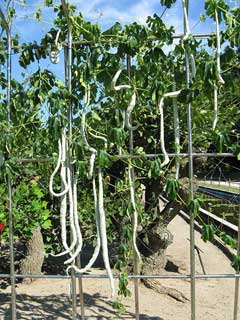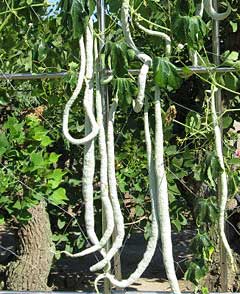 |
|
commons.wikimedia.org/wiki/User:KENPEI |
 |
| commons.wikimedia.org/wiki/User:KENPEI |
Translate this page:
Summary
Physical Characteristics

 Trichosanthes cucumerina anguina is a ANNUAL CLIMBER growing to 5 m (16ft 5in) at a fast rate.
Trichosanthes cucumerina anguina is a ANNUAL CLIMBER growing to 5 m (16ft 5in) at a fast rate.
See above for USDA hardiness. It is hardy to UK zone 10 and is frost tender. It is in flower from July to September, and the seeds ripen from September to October. The species is monoecious (individual flowers are either male or female, but both sexes can be found on the same plant) and is pollinated by Insects.
Suitable for: light (sandy), medium (loamy) and heavy (clay) soils and prefers well-drained soil. Suitable pH: mildly acid, neutral and basic (mildly alkaline) soils. It cannot grow in the shade. It prefers moist soil.
UK Hardiness Map
US Hardiness Map
Synonyms
T. anguina
Plant Habitats
Cultivated Beds;
Edible Uses
Edible Parts: Fruit Leaves Shoots
Edible Uses:
Young fruit - cooked[1, 46, 61]. It can be used in curries or eaten as a vegetable like green beans[2, 86, 183]. Mature fruits can be up to 2 metres long and 10cm thick[2, 200]. The bright red pulp around the mature seeds is extracted and used in cooking in much the same way that tomatoes are used[183]. Leaves and young shoots - cooked[183].
References More on Edible Uses
Medicinal Uses
Plants For A Future can not take any responsibility for any adverse effects from the use of plants. Always seek advice from a professional before using a plant medicinally.
Abortifacient Anthelmintic Emetic Purgative
The fruit is considered to be anthelmintic, emetic and purgative[240]. The seed is said to be cooling[240]. Peptides in the plant are used as an abortifacient in China[284].
References More on Medicinal Uses
The Bookshop: Edible Plant Books
Our Latest books on Perennial Plants For Food Forests and Permaculture Gardens in paperback or digital formats.

Edible Tropical Plants
Food Forest Plants for Hotter Conditions: 250+ Plants For Tropical Food Forests & Permaculture Gardens.
More

Edible Temperate Plants
Plants for Your Food Forest: 500 Plants for Temperate Food Forests & Permaculture Gardens.
More

More Books
PFAF have eight books available in paperback and digital formats. Browse the shop for more information.
Shop Now
Other Uses
References More on Other Uses
Cultivation details
Requires a rich well-drained soil and plenty of moisture in the growing season[1]. Cultivated in India for its edible fruit it is not hardy in Britain, requiring greenhouse cultivation[200], though it may be possible to grow it as an annual in a very warm sheltered bed outdoors[1]. The plant is very variable in the shape of the fruit, there are some named varieties[183]. Plants grow best with short daylengths and stable temperatures above 25°c[200]. Plants climb by means of tendrils[188] and also have a slightly twining stem[219]. A weight is sometimes attached to the growing fruit to ensure that it grows straight[183].
References Carbon Farming Information and Carbon Sequestration Information
Temperature Converter
Type a value in the Celsius field to convert the value to Fahrenheit:
Fahrenheit:
The PFAF Bookshop
Plants For A Future have a number of books available in paperback and digital form. Book titles include Edible Plants, Edible Perennials, Edible Trees,Edible Shrubs, Woodland Gardening, and Temperate Food Forest Plants. Our new book is Food Forest Plants For Hotter Conditions (Tropical and Sub-Tropical).
Shop Now
Plant Propagation
Seed - sow March in pots in a warm greenhouse in a rich soil. Sow 2 - 3 seeds per pot and thin to the strongest plant. Grow them on fast and plant out after the last expected frosts. Give them some protection, such as a frame or cloche, until the plants are growing away well.
Other Names
If available other names are mentioned here
club gourd, serpent gourd, serpent-cucumber, she gua, snake gourd, viper's gourd.
Native Range
Coming Soon
Weed Potential
Right plant wrong place. We are currently updating this section.
Please note that a plant may be invasive in one area but may not in your area so it's worth checking.
Conservation Status
IUCN Red List of Threatened Plants Status : This taxon has not yet been assessed

Growth: S = slow M = medium F = fast. Soil: L = light (sandy) M = medium H = heavy (clay). pH: A = acid N = neutral B = basic (alkaline). Shade: F = full shade S = semi-shade N = no shade. Moisture: D = dry M = Moist We = wet Wa = water.
Now available:
Food Forest Plants for Mediterranean Conditions
350+ Perennial Plants For Mediterranean and Drier Food Forests and Permaculture Gardens.
[Paperback and eBook]
This is the third in Plants For A Future's series of plant guides for food forests tailored to
specific climate zones. Following volumes on temperate and tropical ecosystems, this book focuses
on species suited to Mediterranean conditions—regions with hot, dry summers and cool, wet winters,
often facing the added challenge of climate change.
Read More
Expert comment
Author
(L.)Haines.
Botanical References
200266
Links / References
For a list of references used on this page please go here
A special thanks to Ken Fern for some of the information used on this page.
Readers comment